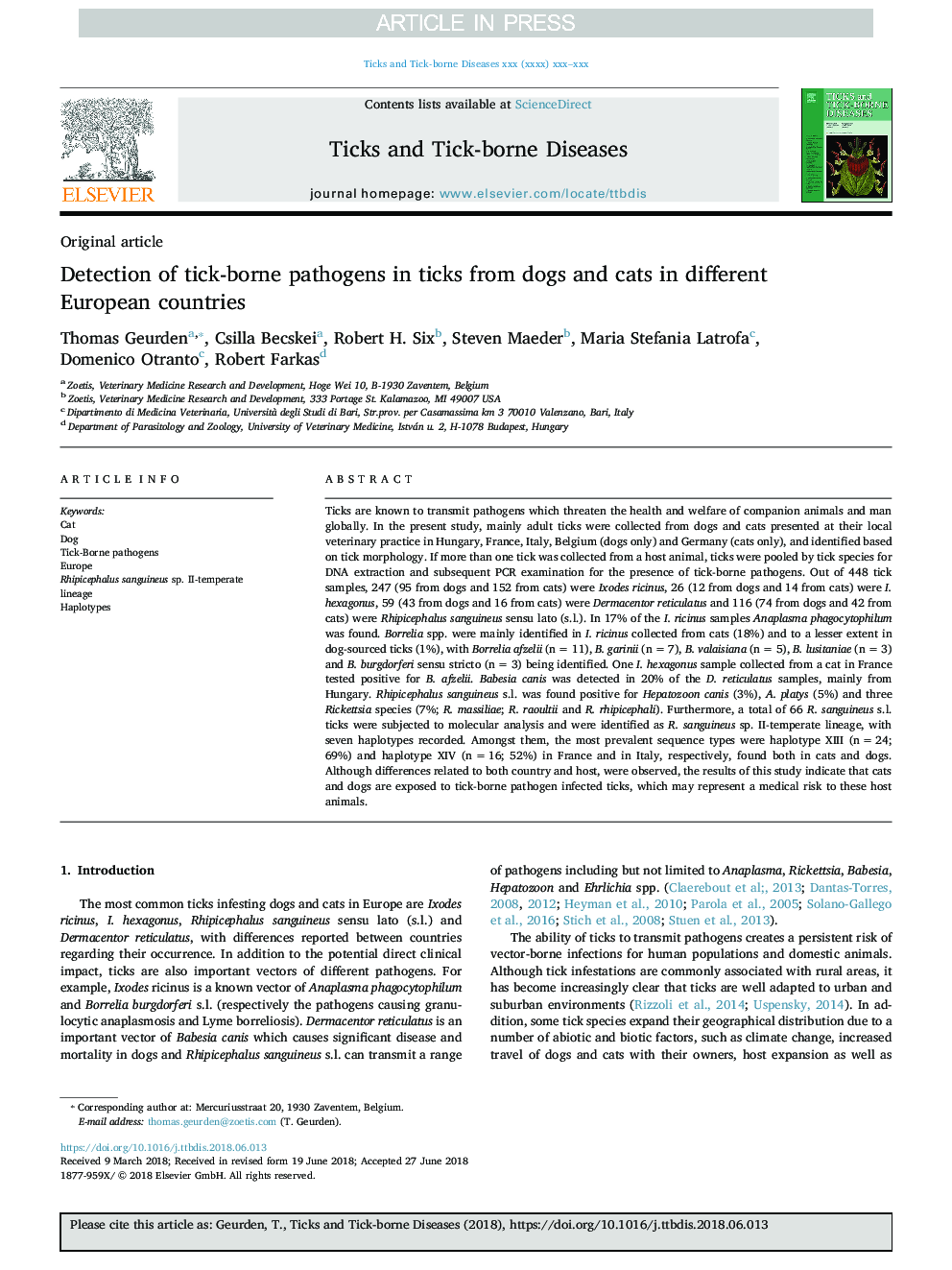| کد مقاله | کد نشریه | سال انتشار | مقاله انگلیسی | نسخه تمام متن |
|---|---|---|---|---|
| 8965628 | 1646730 | 2018 | 6 صفحه PDF | دانلود رایگان |
عنوان انگلیسی مقاله ISI
Detection of tick-borne pathogens in ticks from dogs and cats in different European countries
ترجمه فارسی عنوان
تشخیص پاتوژن های تلقیح شده در کنه های سگ ها و گربه ها در کشورهای اروپایی مختلف
دانلود مقاله + سفارش ترجمه
دانلود مقاله ISI انگلیسی
رایگان برای ایرانیان
کلمات کلیدی
موضوعات مرتبط
علوم زیستی و بیوفناوری
علوم کشاورزی و بیولوژیک
علوم دامی و جانورشناسی
چکیده انگلیسی
Ticks are known to transmit pathogens which threaten the health and welfare of companion animals and man globally. In the present study, mainly adult ticks were collected from dogs and cats presented at their local veterinary practice in Hungary, France, Italy, Belgium (dogs only) and Germany (cats only), and identified based on tick morphology. If more than one tick was collected from a host animal, ticks were pooled by tick species for DNA extraction and subsequent PCR examination for the presence of tick-borne pathogens. Out of 448 tick samples, 247 (95 from dogs and 152 from cats) were Ixodes ricinus, 26 (12 from dogs and 14 from cats) were I. hexagonus, 59 (43 from dogs and 16 from cats) were Dermacentor reticulatus and 116 (74 from dogs and 42 from cats) were Rhipicephalus sanguineus sensu lato (s.l.). In 17% of the I. ricinus samples Anaplasma phagocytophilum was found. Borrelia spp. were mainly identified in I. ricinus collected from cats (18%) and to a lesser extent in dog-sourced ticks (1%), with Borrelia afzelii (nâ¯=â¯11), B. garinii (nâ¯=â¯7), B. valaisiana (nâ¯=â¯5), B. lusitaniae (nâ¯=â¯3) and B. burgdorferi sensu stricto (nâ¯=â¯3) being identified. One I. hexagonus sample collected from a cat in France tested positive for B. afzelii. Babesia canis was detected in 20% of the D. reticulatus samples, mainly from Hungary. Rhipicephalus sanguineus s.l. was found positive for Hepatozoon canis (3%), A. platys (5%) and three Rickettsia species (7%; R. massiliae; R. raoultii and R. rhipicephali). Furthermore, a total of 66 R. sanguineus s.l. ticks were subjected to molecular analysis and were identified as R. sanguineus sp. II-temperate lineage, with seven haplotypes recorded. Amongst them, the most prevalent sequence types were haplotype XIII (nâ¯=â¯24; 69%) and haplotype XIV (nâ¯=â¯16; 52%) in France and in Italy, respectively, found both in cats and dogs. Although differences related to both country and host, were observed, the results of this study indicate that cats and dogs are exposed to tick-borne pathogen infected ticks, which may represent a medical risk to these host animals.
ناشر
Database: Elsevier - ScienceDirect (ساینس دایرکت)
Journal: Ticks and Tick-borne Diseases - Volume 9, Issue 6, September 2018, Pages 1431-1436
Journal: Ticks and Tick-borne Diseases - Volume 9, Issue 6, September 2018, Pages 1431-1436
نویسندگان
Thomas Geurden, Csilla Becskei, Robert H. Six, Steven Maeder, Maria Stefania Latrofa, Domenico Otranto, Robert Farkas,
